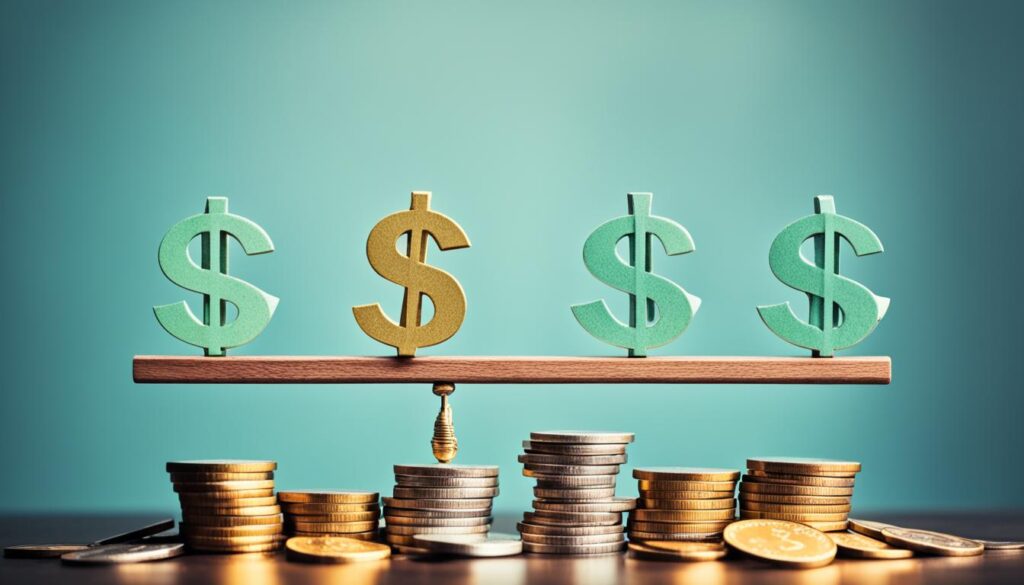Did you know that the average American carries over $101,000 in debt as of 2023? That’s a staggering amount that highlights the urgency of financial education and planning. With such pressure from debt, understanding how to balance paying off debt and saving money has never been more essential for achieving financial stability. Finding that equilibrium is crucial not only for improving your financial outlook but also for ensuring a secure future. In this article, we will explore effective debt repayment strategies and how to create a savings plan that works in harmony with your financial obligations. Recognizing the difference between good and bad debt is a key factor in navigating your finances effectively. Additionally, implementing actionable strategies can help you establish clear savings goals while managing your repayment commitments effectively1
Key Takeaways
- Understanding the critical balance between managing debt and saving is vital for financial stability.
- Learning to distinguish between good and bad debt can inform your debt repayment strategy.
- Setting achievable savings goals keeps you motivated and on track.
- Establishing an emergency fund helps safeguard against unforeseen expenses.
- Employing effective budget techniques can maximize your financial health.
Understanding the Importance of Financial Balance
Finding financial balance involves recognizing the difference between good and bad debt. Understanding these distinctions enables individuals to create effective debt reduction strategies. Good debt usually refers to loans aimed at acquiring appreciating assets, such as a mortgage or student loans that may increase future earning potential. In contrast, bad debt can drain financial resources, especially credit card debt with an average annual percentage rate of over 20%2. Statistics reveal the average credit card interest rate is currently 21.59%, which highlights the cost of maintaining such debt3.
Recognizing Good vs. Bad Debt
Awareness of the distinctions between good and bad debt is essential. Good debt is seen as an investment toward a person’s future, while bad debt often leads to financial strain. Prioritizing repayment of higher-interest debts can significantly benefit long-term financial health, helping to avoid costs that accumulate over time. For example, a $6,500 credit card balance at 21.59% APR could require 124 months to repay if only minimum payments are made, resulting in over $9,000 in interest3.
The Impact of Debt on Financial Health
The impact of debt on financial health can be severe. High levels of bad debt can lead to decreased credit scores and limited borrowing capacity, making it difficult for individuals to make investments or save effectively. Approximately 64% of Americans miss out on potential savings account interest due to these financial challenges2. Establishing an emergency fund containing three to six months of expenses is vital to safeguard against unexpected financial setbacks, allowing individuals to avoid reliance on credit cards in difficult times2.

How to Balance Paying Off Debt and Saving Money
Achieving financial stability means navigating the delicate balance between paying off debt and saving money. The zero-sum game of budgeting revolves around allocating every dollar intentionally. By focusing your efforts on setting financial priorities, you can manage debt effectively while building your savings.
The Zero-Sum Game of Budgeting
In a zero-sum budgeting approach, each dollar must serve a purpose—covering debts, fundamental expenses, or savings. It is crucial to build an initial cash buffer of $1,000 to address unexpected costs and maintain flexibility in spending plans. Unfortunately, only 44 percent of Americans can cover a surprise expense of $1,000 or more with their savings, highlighting the need for emphasis on emergency funds4.
Save at least 3 to 6 months worth of essential expenses in an emergency fund to provide a safety net. The need for such measures is evident, with 43 percent of U.S. adults citing emergencies or unforeseen expenses as the main reasons for accumulating debt4.
When setting priorities within your financial strategy, addressing debts should come after securing a safety net. Consider focusing on employer-matched retirement savings to maximize available contributions. Strive to allocate at least 15 percent of your pretax income to retirement savings each year and attempt to capture the full employer match5. Utilize debt repayment strategies, like the snowball or avalanche method, to tackle high-interest debts while ensuring that all minimum payments are timely made to protect your credit score5.
Optimally, your budget should allocate 50 percent for needs, 30 percent for wants, and 20 percent for savings and debt repayment, promoting a healthy financial balance. By understanding how to balance paying off debt and saving money, you deliver yourself a stronger foundation for future financial growth5.

Debt Repayment Strategies for Financial Growth
Understanding effective debt repayment strategies is essential for achieving financial growth while managing multiple debts. Two prominent methods often discussed are the Snowball and Avalanche approaches, each with unique strengths that cater to different financial situations.
Common Approaches: Snowball vs. Avalanche Methods
The Snowball method encourages individuals to focus on paying off the smallest debts first. This strategy often provides a psychological boost as borrowers experience quick wins, which can be motivating6. On the other hand, the Avalanche method prioritizes debts according to their interest rates. By tackling high-interest debts first, borrowers ultimately save more on interest payments, which can lead to quicker overall debt payoff and savings goals6.
It’s essential to note that while both strategies can be effective, the choice between them may depend on personal preferences and financial circumstances. For those needing motivation, the Snowball method may be preferable, while individuals focused on minimizing total interest costs might opt for the Avalanche method. Organizing debts into a comprehensive list, including balances, interest rates, and minimum payments, can aid in determining which method aligns best with one’s financial health tips and goals6.
Using Income from Investments to Manage Debt
Utilizing income generated from investments can provide an innovative avenue for managing debt. For example, directing returns from stocks or dividends into debt repayment can significantly enhance cash flow7. This approach not only supports ongoing financial health but also ensures that investments continue to work towards long-term savings goals while concurrently paying down existing debt.
In addition to employment income, exploring extra cash from side incomes or bonuses can also be strategically allocated. Recognizing how to balance debt payments while building savings is crucial—financial experts recommend automating these efforts wherever possible. The practice of contributing to retirement accounts, ensuring an emergency fund, or directing part of these earnings to reduce high-interest debt can collectively contribute to improved financial management and growth over time7.
Creating a Savings Plan Alongside Debt Repayment
Establishing a well-structured savings plan is vital for maintaining financial stability, especially when balancing debt repayment. Prioritizing savings alongside debt payment not only shelters against unexpected costs but also prepares for long-term financial goals.
Emergency Fund Essentials
One of the most critical components of a healthy savings plan is establishing an emergency fund. Financial experts recommend starting with an initial goal of $1,000 before aiming for a larger buffer that covers three to six months of living expenses8. This fund acts as a safety net, helping to mitigate the need for additional debt in times of unexpected financial strain. A consistent saving strategy could involve setting aside approximately $84 monthly to reach the initial target within one year8.
Saving for Retirement with Debt in Mind
While focusing on repaying debt, it is equally important to allocate funds towards retirement savings. Investing in a 401(k) or an IRA allows individuals to take advantage of compounding interest and employer matching contributions, typically ranging between 3% to 5% of an employee’s pay9. A well-rounded savings plan should ideally include saving 20% of take-home pay for financial goals, which combines both retirement contributions and emergency fund growth10. By integrating these important saving strategies into your financial plan, you set yourself up for future success without sacrificing current debt repayment.
Budgeting Advice to Maximize Your Financial Health
Effective budgeting is key to enhancing your financial health. Utilizing strategies such as the 50/30/20 rule can simplify managing personal finances. This rule dictates that 50% of your after-tax income should go towards needs, while 30% is reserved for wants, and 20% should focus on savings and additional debt repayment beyond minimums11
Implementing the 50/30/20 Rule
The implementation of the 50/30/20 rule allows you to allocate your funds based on immediate needs and long-term goals. Prioritizing an emergency fund should be your first financial objective, with a recommendation to save at least $500 initially to manage minor emergencies11. An effective rule of thumb entails setting aside 15% of your gross income for retirement savings, including any available company matches, particularly after addressing high-interest debt11. Aiming to build an emergency fund with 3 to 6 months of essential living expenses ensures preparedness for unforeseen expenses without resorting to debt11.
Avoiding Common Budgeting Pitfalls
Recognizing and avoiding common budgeting pitfalls can dramatically improve your financial situation. Overlooking irregular expenses can lead to budget imbalances, and failing to monitor changes in income or expenses can increase the risk of financial shortfalls11. It is prudent to automate savings to create consistency, while still allocating funds for discretionary spending to maintain flexibility11. Lastly, managing different types of debt should be prioritized based on urgency and interest rates, focusing primarily on high-interest debts such as credit cards and payday loans12.
Money Management Techniques for Long-Term Success
Achieving long-term financial success requires a thorough understanding of money management techniques, particularly the importance of continuously monitoring your financial progress. Regular evaluations of your budgeting, debt repayment, and savings will ensure that you remain on track despite changing circumstances. For instance, many American consumers are currently facing challenges, with 36% having more credit card debt than emergency savings, highlighting the critical need for consistent tracking and adjustment of financial plans to avoid unnecessary strain13.
Monitoring Your Financial Progress
Establishing a routine for monitoring your financial health is essential, as it allows you to identify trends and areas that may require immediate attention. For example, understanding the impact of high-interest debts can help prioritize which debts to tackle first, fostering a clearer path to financial stability. As economic conditions fluctuate, including inflation rates that peaked at 9.1% in June 2022, adapting your strategies can help mitigate financial risks and enhance your ability to save effectively1413.
Adjusting Strategies Based on Changing Circumstances
Life can bring unexpected changes, whether it’s shifts in income or market conditions, emphasizing the need for adjusting strategies accordingly. Regularly reassessing your financial goals and considering options, such as consolidating high-interest loans or utilizing balance transfer cards with 0% APR periods, can provide much-needed relief in managing debts. Furthermore, a proactive approach to budgeting and spending can significantly aid in establishing an effective savings foundation, ensuring you’re better equipped to handle debt while securing your financial future14.
FAQ
How can I balance paying off debt and saving money effectively?
What is the difference between good debt and bad debt?
What are some effective debt repayment strategies?
How much should I save in my emergency fund?
How can I ensure I’m on track with my financial goals?
What budgeting techniques can improve my financial health?
Why is saving for retirement important while paying off debt?
Source Links
- https://myearnup.com/is-it-better-to-pay-off-debt-or-save-money/
- https://www.cnet.com/personal-finance/banking/savings/should-i-save-money-or-pay-off-debt-first/
- https://www.investopedia.com/financial-edge/0212/saving-vs.-paying-off-debt.aspx
- https://www.bankrate.com/banking/savings/these-guidelines-will-help-you-decide-whether-to-pay-down-debt-or-save/
- https://www.fidelity.com/viewpoints/personal-finance/how-to-pay-off-debt
- https://www.equifax.com/personal/education/debt-management/articles/-/learn/prioritize-debt-payments/
- https://www.creditkarma.com/advice/i/balancing-saving-and-paying-debt
- https://www.truist.com/money-mindset/principles/stress-free-saving/save-money-or-reduce-debt
- https://www.experian.com/blogs/ask-experian/how-to-save-and-pay-off-debt-at-the-same-time/
- https://www.capitalone.com/learn-grow/money-management/how-to-save-money-and-pay-debt/
- https://www.nerdwallet.com/article/finance/how-to-budget
- https://www.equifax.com/personal/education/debt-management/articles/-/learn/paying-off-debt-strategies/
- https://www.cnbc.com/2023/08/02/how-to-save-money-and-pay-off-loans-simultaneously.html
- https://www.tiaa.org/public/learn/retirement-planning-and-beyond/managing-your-money/seven-steps-to-more-effectively-manage-and-reduce-your-debt

